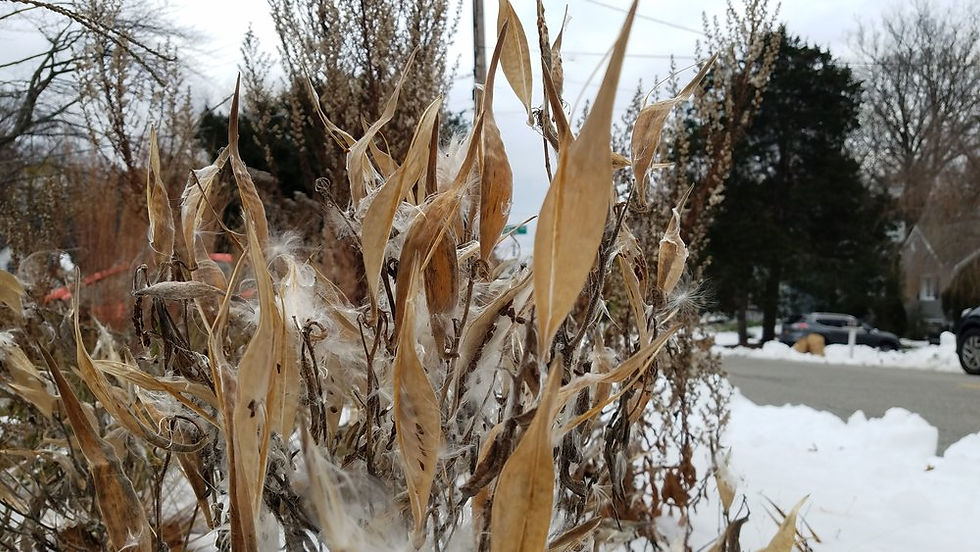Fall Garden Care for Pollinators
- Lynn White
- Oct 1, 2019
- 3 min read
As we begin to think about putting our gardens to bed for the coming winter, think about the winter habits of our friends the pollinators. Although most people still hold with the idea of cleaning flower and garden beds by trimming plants to the ground and covering everything with mulch, this is far from the best option for pollinators. Popular opinion though, is to leave things just as they are through out the winter— decayed and drab, but incredibly beneficial. Isn't that great? A reason to procrastinate and leave the stubble still standing!
With our thoughts focused on winter care for pollinators, we need primarily focus on their most basic necessity, shelter. Here are how some pollinators find winter shelter:

Butterflies
Certain species of butterflies have evolved the capability of producing anti-freeze, which protects them if temperatures fall below freezing. These include the comma (Polygonia c-album) and question mark (Polygonia interrogationis) butterflies who find a snug piece of bark or a dried leaf to nestle under until spring.
Other species overwinter as a chrysalis, the form a caterpillar takes before it emerges from its cocoon. These would include cabbage white (Pieris rapae), sulphurs (Phoebis spp.), and members of the swallowtail family (Papilionidae). Many of these chrysalises can be found either hanging from dead plant stems or tucked into the soil or leaf litter. While others spend the winter as a caterpillar; good examples of these species would be red-spotted purple (Limenitis arthemis), meadow fritillary (Boloria bellona), and viceroy (Limenitis archippus) who hibernate among the vegetation, in seed pods, in silken nests, and in rolled-up leaves. You can guess what kind of damage a fall gardening clean-up would do to them.
During mild spells, the caterpillars of some species will resume feeding. We don’t want to shut down their buffet by trimming back all of the plants in your garden.
Bees
Standing plants are important for many species of bee. Several species of solitary bees hide in the hollow stems of plants, such as bee balm. You can also install a bee hotel which is readily inhabited by mason bees. These young adult bees spend the winter in diapause, a period of suspended development, especially during unfavorable environmental conditions.
Other bee species burrow into the ground, this is why we should never cover the entire garden or flower bed in mulch; leave some area bare. Make sure these bare areas are not on a slope however, otherwise you may experience erosion caused by the winter rain and snowmelt.

Beetles
Ladybugs are great pest eaters, with each one consuming dozens of soft-bodied pest insects and insect eggs every day. Leaving the garden intact for the winter means that along with the help of ladybugs you’ll get a jump start on pest control for the spring.
None of our native ladybug species have any interest in spending the winter inside of your house. If you see ladybugs invading your home, this is the introduced Asian multicolored ladybug. For the most part native ladybugs spend the colder months tucked under a pile of leaves, nestled at the base of a plant, or hidden under rocks. The majority of them overwinter in groups, with anywhere from a few individuals to thousands.
So What Should You Do in the Fall?
In some subdivisions, you might get a few comments about your garden looking too “natural” or a little too shabby. If that is the case, clean-up your front yard and let the pollinators enjoy the garden beds in the backyard. Or, install a small sign explaining that your garden bed is intentionally left like this to improve the health of pollinators.
So wait until spring before heading out with your pruning shears, but of course if you have ailing plants, remove those to help with disease control. Also, remove any materials from the garden that might have fungus on it. However, if its simply dead, leave it alone.

If you’re not ready to kick your feet up and relax, you can help the Monarch Butterfly population simply by collecting milkweed seed pods. Butler Soil and Water Conservation District is the local drop-off point for Common Milkweed Seed Pods; running until October 30th pods can be dropped off Monday through Friday between the hours of 8am - 4:30pm.
To find out more visit www.ButlerSWCD.org/pollinators






















